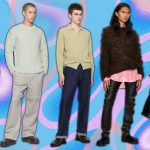Sargent spoke to GQ about the under-appreciated facets of Barkley Hendricks and his work, the some of the overlaps between fashion and art, and realizing Hendricks worked like a stylist.
GQ: Why did showing Barkley Hendricks and his work directly alongside the The Frick Collection, which features European paintings from the Renaissance through the 1800s, speak to you?
Antwaun Sargent: It really allows you to draw connections between the past and the present. You can think about costuming. You can think about jewelry design. You can think about old master painting techniques and the relationship and conversation that continues in the present moment. These are not just paintings that were painted centuries ago. They continue to inform us.
I think when Barkley Hendricks was a youth, traveling around Europe and visiting the Louvre and other institutions, it really ignited in him a deep understanding, but also an engagement, in making sure we were having a full conversation. A conversation that included folks who looked like him and lived in his neighborhood. His family, his friends, fly people who were walking down the street all dressed up. For so long, these images were often of people in power—kings and queens. In painting ordinary folks on the street, Hendricks was saying: these people! He knew they had power. too. They had beauty, and a sense of self, and self-possession that we should take a moment to consider.
Lawdy Mama, 1969The Studio Museum in Harlem, New York; gift of Stuart Liebman, in memory of Joseph B. Liebman Artwork; Barkley L. Hendricks; courtesy of the Estate of Barkley L. Hendricks and Jack Shainman Gallery, New York
What aspects of Hendricks’ career do you attempt to explore and unpack through your curation?
We explore his most prolific period of portraiture. Which, really, was the late Sixties through the late Seventies. This was a time he mostly focused on making portraits. After that, through the Eighties and the early Two Thousands, he really shifted more of his focus to landscape paintings, drawing, photography, and other things. We really wanted to show Hendricks at his most engaged with the genre of portrait painting. So we focused on the Seventies, and what all that means in terms of style, the Black Power movement, the post-Civil Rights era, and Black people redefining themselves. And one of the ways that people redefine themselves is through the things that they wear. Barkley Hendricks captured that redefinition as it was happening.
As you just mentioned, fashion really is a focus of Hendricks and his portraiture. The images sometimes feel like they belong in a fashion magazine, right? How does style operate in his work from this period?
Hendricks, in a way, worked like the street style vloggers of today. He photographed all of his sittings, which were of all the people he painted. He would photograph them out on the street. We included some of those photos in the exhibition’s book and you can see how the subjects are really going for it and striking poses. But Hendricks didn’t simply capture his subjects.
He also styled them, later, during the painting process. There is one work: In the original photograph, the subject is wearing a yellow and blue leotard. But in the painting, he edits the blue out and makes it all yellow. He also removes a necklace—the subject had one. He’s making choices that a stylist would make.



